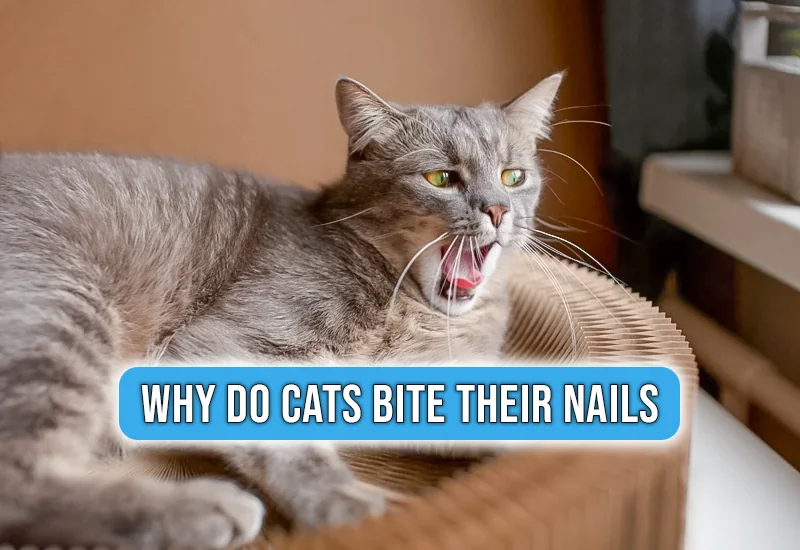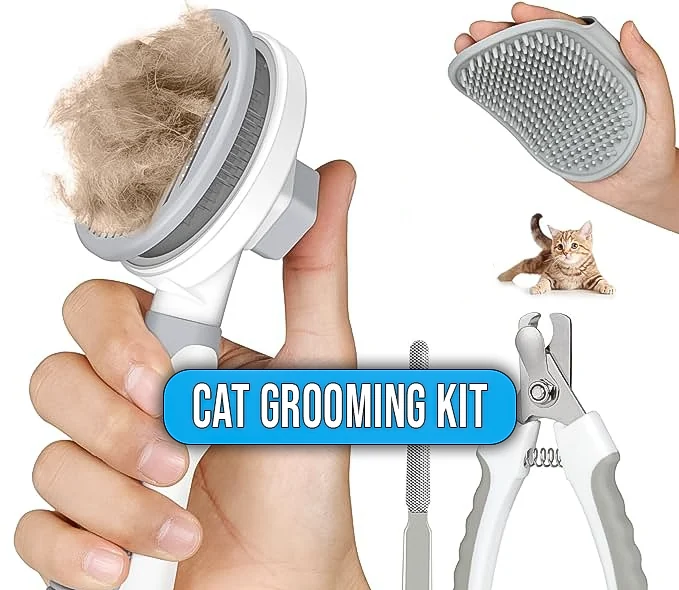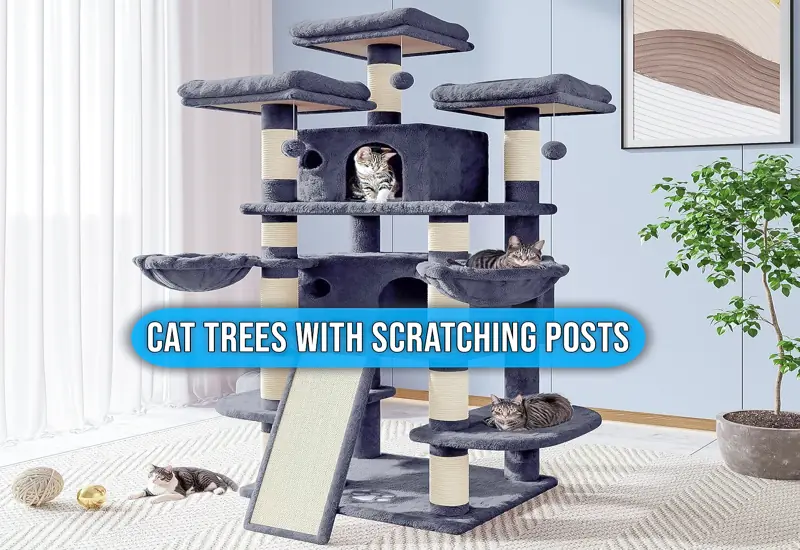Why Do Cats Bite Their Nails?
Updated: 2 Jul 2024
495
Introduction to Feline Nail-Biting Behavior

Have you ever caught your cat in the act of biting their nails and wondered why they do it? It’s a common question among cat owners, and understanding this behavior is crucial for ensuring your feline friend’s health and well-being.
This comprehensive article aims to explain the detail behind cat nail-biting, exploring its causes, implications, and when it might be a sign of underlying issues.
Cat Facts on Nail-Biting Stats and Feline Insights
In this table, there is interesting data related to cat nail-biting behavior.
| Fact/Statistic | Data | Relevance |
|---|---|---|
| Percentage of cats that engage in nail biting | Approximately 65% | Shows how common this behavior is among cats |
| Average time spent on nail biting during daily grooming | 2-5 minutes | Indicates normal duration for this behavior |
| Percentage of excessive nail biters with underlying medical issues | Up to 40% | Suggests a higher prevalence in older cats, possibly due to health issues |
| Frequency of nail shedding in healthy cats | Every 8-10 weeks | Explains why cats naturally engage in nail maintenance |
| Percentage of nail-biting behavior reduced by providing scratching posts | Up to 70% | Demonstrates effectiveness of environmental enrichment |
| Proportion of nail-biting cases linked to anxiety or stress | Approximately 25-30% | Emphasizes the role of mental health in this behavior |
| Percentage of cats showing increased nail biting during environmental changes | Up to 50% | Illustrates impact of stress on nail-biting behavior |
| Average age when kittens start nail-biting behavior | 3-4 weeks old | Indicates when this natural behavior typically begins |
| Percentage of geriatric cats (over 11 years) showing increased nail-biting | About 35% | Suggests higher prevalence in older cats, possibly due to health issues |
| Proportion of nail-biting cases resolved with proper diagnosis and treatment | Up to 85% | Encourages seeking veterinary help for persistent nail biting |
Normal Grooming Behavior: A Closer Look
Cats are meticulous groomers, dedicating a significant portion of their day to self-care. Nail biting, or more accurately, nail chewing, is an integral part of this grooming routine. Cats use their teeth to remove the outer layer of their nails, a process that serves multiple purposes:
- Maintaining nail health: Regular nail maintenance helps keep a cat’s claws sharp and clean.
- Removing debris: Chewing helps remove dirt and other particles that may accumulate under the nails.
- Nail trimming: This natural behavior helps cats manage their own nail length.
Interestingly, kittens learn this behavior from their mothers during early grooming lessons. It’s part of their innate instinct to keep themselves clean and ready for any situation. However, excessive nail-biting behavior can sometimes indicate underlying issues that require attention.

The Role of Scratching Posts and Environmental Enrichment
While nail biting is normal, cats with access to appropriate scratching surfaces may engage in less frequent nail chewing. Scratching posts, cat trees, and other textured surfaces provide cats with alternative ways to maintain their claws. These items also offer:
- Muscle stretching opportunities
- Territory marking
- Stress relief
Providing a variety of scratching surfaces in your home can help reduce excessive nail-biting and promote overall nail health.

Injuries, Infections, and Medical Issues
Excessive nail biting can sometimes be a sign of underlying medical problems. If you notice your cat focusing intensely on their nails or engaging in abnormal nail chewing, it could indicate:
- Nail bed infections: These can cause discomfort and lead to increased nail biting.
- Foreign objects: Something lodged in the paw can prompt excessive grooming.
- Broken toes or other physical injuries: Pain can manifest as increased attention to the affected area.
- Fungal infections: Conditions like ringworm can affect the nails and surrounding skin.
- Yeast infections: These can cause irritation and discomfort in the nail area.
It’s crucial to seek veterinary attention if you notice any changes in your cat’s grooming habits or signs of discomfort. Left untreated, these conditions can lead to more severe health issues and permanent damage.
Skin Conditions and Serious Illnesses
Certain skin conditions and systemic illnesses can manifest as nail-related problems, leading to increased nail-biting behavior. Some of these include:
- Pemphigus foliaceus: This rare autoimmune disease can cause painful sores on the paw pads.
- Dermatophytosis: A fungal infection that can affect the nails and surrounding skin.
- Onychomycosis: A specific fungal infection of the nails.
- Paraneoplastic pemphigus: A rare condition associated with certain types of cancer.
In some cases, nail problems can be an early indicator of more serious health concerns. Regular check-ups with your vet can help catch and address these issues early.
Anxiety, Stress, and Behavioral Issues
Just like humans, cats can experience stress and anxiety. These emotional states can manifest in various ways, including excessive nail biting. For some cats, nail chewing becomes a self-soothing behavior or coping mechanism when they’re experiencing stress. Factors that might contribute to anxiety in cats include:
- Changes in environment
- New pets or family members
- Lack of mental stimulation
- Separation anxiety
Providing a safe, enriched environment can help reduce stress-related behaviors. This might include:
- Interactive toys for mental stimulation
- Multiple hiding spots and elevated perches
- Regular playtime and attention
- Maintaining a consistent routine
In severe cases, your vet might recommend anti-anxiety medication or behavioral therapy to address persistent nail-biting behavior.
When to Seek Veterinary Attention
While occasional nail biting is normal, certain signs warrant a trip to the vet:
- Excessive, focused nail biting
- Nail biting accompanied by signs of pain or discomfort
- Nail biting leading to hair loss, skin lesions, or inflammation
- Persistent nail biting despite environmental enrichment
- Changes in nail appearance or structure
- Signs of infection, such as swelling or discharge
These could be indicators of underlying health issues that need professional attention. Remember, early intervention is key to preventing more serious problems.
Nail Biting in Kittens: A Natural Learning Process
Even very young kittens engage in nail biting as part of their grooming routine. They learn this behavior from their mothers and littermates. If you see a kitten biting their nails, it’s typically nothing to worry about. However, if the behavior seems excessive or is causing the kitten distress, consult with a vet to rule out any potential issues.
The Importance of Regular Nail Care
While cats are generally adept at maintaining their own nails, some may benefit from regular nail trims, especially if they’re indoor cats or seniors. Here are some tips for maintaining your cat’s nail health:
- Provide multiple scratching surfaces with different textures
- Regularly inspect your cat’s nails for any abnormalities
- Consider gentle nail trimming if recommended by your vet
- Use positive reinforcement to make nail care a positive experience
Remember, never attempt to trim your cat’s nails if you’re unsure how to do it safely. Your vet or a professional groomer can demonstrate the proper technique.
Conclusion: Understanding Your Cat’s Nail-Biting Behavior
Occasional nail biting is a normal part of a cat’s grooming routine. However, it’s important to monitor for changes and seek veterinary care when necessary. By understanding the various factors that can contribute to excessive nail biting – from anxiety and stress to medical issues and environmental factors – you can better care for your feline friend’s overall health and well-being.
Remember, every cat is unique and may exhibit different behaviors. If you’re ever in doubt about your cat’s nail-biting habit or any other behavior, don’t hesitate to seek professional advice. Your cat’s health and happiness are worth it!
I hope this expanded article has been informative and helpful in understanding the complexities of cat nail-biting behavior. As cat owners, our role is to be observant, provide a nurturing environment, and seek help when needed. By doing so, we can ensure our fur babies lead happy, healthy lives. Happy cat parenting!
Is nail biting normal behavior for cats?
Yes, occasional nail biting is part of a cat’s normal grooming routine to maintain claw health.
When should I be concerned about my cat’s nail-biting behavior?
Seek veterinary attention if you notice excessive nail chewing, signs of pain, or changes in your cat’s paws or nails.
How can I prevent my cat from biting their nails excessively?
Provide scratching posts, interactive toys for mental stimulation, and a stress-free environment to reduce nail-biting behavior.
Could nail biting indicate a medical issue in cats?
Yes, excessive nail biting might signify underlying health problems like infections, skin conditions, or pemphigus foliaceus.
Do kittens bite their nails more than adult cats?
Kittens often engage in nail biting as they learn grooming behaviors, but excessive biting at any age should be monitored.
Can fungal infections like ringworm cause increased nail biting in cats?
Yes, ringworm and other fungal infections can cause discomfort, leading to increased nail biting and paw attention.
How often should I trim my cat’s nails to prevent excessive biting?
Regular nail trims every 2-3 weeks can help maintain nail health and reduce the need for excessive biting.
Can separation anxiety in cats lead to nail-biting behavior?
Yes, separation anxiety can manifest as various behaviors in cats, including excessive grooming and nail biting.
Are certain cat breeds more prone to nail-biting behavior?
While nail biting can affect any cat, some breeds may be more prone to anxiety-related behaviors, potentially including nail biting.
Can anxiety cause nail biting in cats?
Yes, stress and anxiety can lead to excessive nail biting as a coping mechanism in cats.

Please Write Your Comments